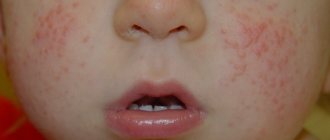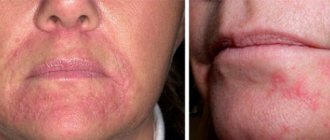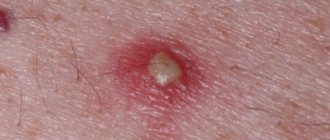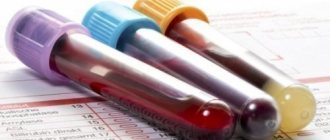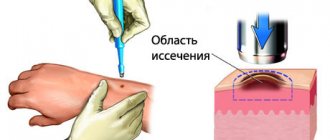What kind of disease is this?
Inguinal dermatitis is a skin disease that manifests itself in the form of inflammation or irritation of the skin on the genitals or intimate area. It can occur in all people, regardless of gender or age. In most cases, the disease is accompanied by minor redness in the pubic area. Sometimes the patient may experience itching. Familiarization with the symptoms will allow you to always be on alert and, if necessary, begin treatment on time.
There are several types of this disease:
- if formations in the groin area visually resemble scales or papules, then this is most likely candidiasis or ordinary dermatitis. It is known to attack the patient's mucous membrane. Candidiasis is a fungal disease that occurs in people with weak immune systems. Impaired immunity can be caused by the use of contraceptives, antibiotics, diabetes, cancer;
- if the appearance of scales or spots in the intimate area is accompanied by unpleasant sensations (itching), then this is seborrheic dermatitis. The formations can spread to the penis or labia. This type of dermatitis is chronic. A feature of the disease is that its symptoms worsen in the autumn-winter period. Corticosteroids are used as therapy. In some cases, doctors prescribe a course of ultraviolet radiation. With the arrival of warmth, the symptoms of seborrheic dermatitis subside. This is due to the exposure of the patient's skin to the required amount of ultraviolet rays;
- Dermatophytosis is characterized by the fact that the patient develops a rash in the groin area or on the labia, which is fungal in nature. This disease can be very easily contracted through contact: through bed linen, towels and other personal hygiene items. The ideal conditions for the development of fungus are a warm and humid place. The pubic area is perfect for this. To prevent dermatophytosis, doctors strongly recommend that patients observe personal hygiene rules;
- if the patient has spots and scales in the intimate area, this indicates erythrasma. In this case, treatment of dermatitis is carried out using ointments, gels or creams that have antibacterial properties.
In rare cases, a rash in the intimate area may form due to the development of chronic psoriasis. This disease is classified as a hereditary disease. Unfortunately, it is impossible to get rid of the symptoms forever, but quick and correct treatment will allow you to achieve remission over a long period of time.
Therapy methods
To treat eczema on the legs near the groin, traditional and traditional medicine methods are used. To cure the disease, it is necessary to destroy the fungal colony and restore the integrity of the epidermis.
In cases of impaired immune defense or functioning of the endocrine system, it is recommended to undergo additional therapy to eliminate the causes of the pathology. A low level of immunity contributes to the development of bacterial, fungal and viral flora both inside the body and on human skin.
Medications
You need to start treatment immediately after detecting the first signs of eczema. At the onset of the disease, ointments and gels for topical use are helpful, and for the treatment of advanced forms, a course of systemic medications is prescribed: Itraconazole, Terbinafine. The duration of the course and dosage of medications is prescribed by the attending physician, taking into account the general condition of the patient, the stage of the disease and the list of contraindications.
In advanced cases, for the treatment of large areas of affected skin, it is recommended:
- use of 10% potassium chloride solution (intravenous administration);
- taking antiallergic drugs (Diphenhydramine, Tavegil, Fenkarol);
- use of specialized antibiotic and antifungal drugs;
- vitamin complexes.
Why does it appear in children, men and women?
There can be many causes of inguinal dermatitis. In some cases, the patient himself is to blame for the development of the disease, but most often it happens on its own.
Common causes of the disease:
- allergic reactions to items or personal hygiene products. There are often cases in women when the use of sanitary pads made of low-quality materials leads to the appearance of symptoms of dermatitis in the groin area;
- increased sweating (hyperhidrosis), caused by the individual genetic characteristics of the patient, can provoke the development of genital dermatitis;
- careless attitude to the rules of personal hygiene. If a person does not follow the rules of hygiene in the intimate area, then active proliferation of microorganisms will most likely occur there. This in turn will lead to skin irritation and itching;
- Obesity of varying degrees often leads to the formation of anal dermatitis. During the warm season, when a person prone to obesity begins to sweat a lot, intense friction occurs between the inner thighs. Over time, irritation appears there;
- Uncomfortable underwear or clothing can also trigger the development of inguinal dermatitis. Skin irritation occurs due to rough fabric, the presence of lace inserts or poorly sewn wardrobe items;
- diseases of the gastrointestinal tract (GIT) in rare cases can cause dermatitis in the groin area. It may be caused by ulcerative colitis or enterocolitis;
- worms;
- poor functioning of the patient’s immune system or intestinal dysbiosis;
- Driving a car for a long time or riding horses often leads to the formation of inguinal dermatitis.
To become infected with dermatitis, you do not need to do any special rituals; this is done very quickly and easily. For example, when visiting a public toilet or bathhouse. The main thing is to identify and treat the disease in time. In this case, you can avoid the discomfort caused by dermatitis.
Prevention
It is impossible to cure dermatitis in children in one day. Sometimes treatment for dermatitis takes several years.
Ointment and cream can only relieve the symptoms of the disease. The best remedy for food rash is constant monitoring of the menu of mother and baby, the use of creams to combat allergic reactions and diaper rash, and the prevention of infection and acute skin inflammation. With the strengthening of the body and the formation of intestinal microflora, the rashes on the hands and head disappear.
Inguinal dermatitis is an inflammatory disease that develops as a result of exposure to an external or internal irritant on the skin of the pubis, perineum and genital organs. Can occur at any age. Men, women, and small children get sick with equal frequency. In most cases, the cause of the development of pathology is a fungal infection, but there are other provoking factors.
Symptoms and diagnosis
The peculiarity of inguinal dermatitis is that its symptoms cannot be confused with anything else. You have to try hard not to notice the signs of this pathology.
Symptoms of inguinal dermatitis:
- the skin in the intimate area begins to peel off;
- severe itching is felt;
- sometimes the disease may be accompanied by pain;
- the skin in the affected areas changes its color to red and swells slightly;
- a dried “frame” appears around the source of inflammation;
- Small pustules form on the skin.
The appearance of symptoms of inguinal dermatitis may also indicate the presence of other diseases. For example, this could be a bladder disease, acute respiratory viral infection, or certain problems with the patient’s kidneys.
Treatment tips
When the dermatologist made the final diagnosis and it became clear that it was inguinal dermatitis, the patient was prescribed a course of medications. When there are no chronic pathologies, treatment consists of treating the intimate area with special compounds. The most popular drugs:
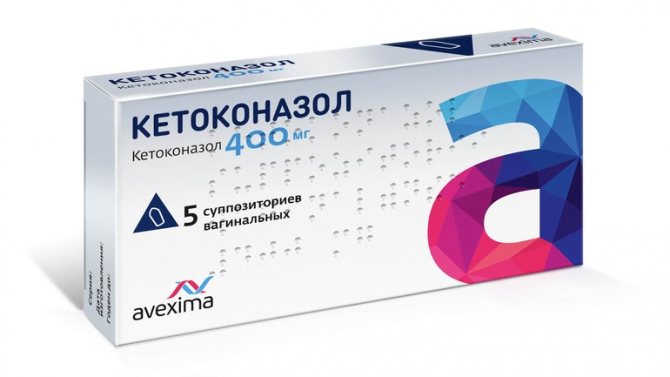
- Ketoconazole;
- Triderm;
- Miconazole;
- Clotrimazole.
The intended purpose of such creams and ointments is to fight inflammation, suppress fungus and bacteria, and get rid of swelling and itching. The ointment should always be applied to the skin , the surface of which has been thoroughly washed. For cleaning purposes, you should use baby soap or tar soap. You can take any water, including from the tap. Any other cosmetics and care products should be excluded. The medicinal ointment is applied in a thin layer over the entire surface of the lesions.
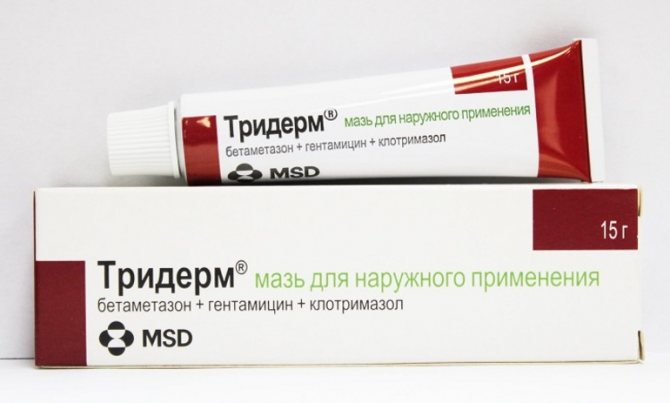
To treat inguinal dermatitis with maximum effectiveness, treatment is recommended after cleansing the skin. Also, the surface of the epidermis must be dried. From time to time, the covers should be sprinkled with baby talcum powder.
Antiseptic solutions may be additionally prescribed for the treatment of groin dermatitis in women and men.
Chlorhexidine or potassium permanganate are commonly used. Furacilin in powder form is also widely used. These medicines are considered safe. They are good at cleaning the intimate area, which is affected by accumulations of pathogenic microorganisms.
Epithelial cells renew themselves quickly. When potassium permanganate is used, a solution that has a pale pink tint should be prepared based on it. If it is too saturated, a person risks getting burned.
How to treat?
To treat inguinal dermatitis, you do not need to use special medical equipment. This procedure is very simple, but this does not mean that you can do the treatment yourself, without the help of a qualified specialist. Before using any medication, you must consult a dermatologist. As a rule, doctors prescribe external medications, but sometimes various folk remedies can be used as a supplement.
Therapy methods
To treat eczema on the legs near the groin, traditional and traditional medicine methods are used. To cure the disease, it is necessary to destroy the fungal colony and restore the integrity of the epidermis.
In cases of impaired immune defense or functioning of the endocrine system, it is recommended to undergo additional therapy to eliminate the causes of the pathology. A low level of immunity contributes to the development of bacterial, fungal and viral flora both inside the body and on human skin.
Medications
You need to start treatment immediately after detecting the first signs of eczema. At the onset of the disease, ointments and gels for topical use are helpful, and for the treatment of advanced forms, a course of systemic medications is prescribed: Itraconazole, Terbinafine. The duration of the course and dosage of medications is prescribed by the attending physician, taking into account the general condition of the patient, the stage of the disease and the list of contraindications.
In advanced cases, for the treatment of large areas of affected skin, it is recommended:
- use of 10% potassium chloride solution (intravenous administration),
- taking antiallergic drugs (Diphenhydramine, Tavegil, Fenkarol),
- the use of specialized antibiotic and antifungal drugs,
- vitamin complexes.
» alt=»»> In addition to taking medications internally, the patient needs to use external agents:
- Fukortsin,
- Boron-naphthalan ointment,
- Ethacridine (under a bandage),
- Furacilin,
- Undecine ointment,
- Sulfur-salicylic ointment,
- Decamine ointment.
Dressings and lotions help prolong the therapeutic effect of ointments, but you must remember to replace them in a timely manner.
The most popular antifungal drugs include:
If side effects or signs of allergy occur, the patient should consult a specialist to prescribe an analogue of the drug.
Unconventional methods
Folk remedies are used during the period of remission of skin diseases, for prevention or as an addition to the main elements of treatment.
- Mix equal parts chopped small-leaved basil and centipede larch. For 3 tablespoons of the mixture you will need 0.5 liters of boiling water. Leave until the color is rich and add 1 glass of strained liquid to the water while taking a bath. The average duration of the procedure is 20 minutes, the bath is repeated up to 12 times. The water should be warm, since prolonged hot baths can negatively affect the functioning of the heart.
- Combine equal parts of dried St. John's wort, lingonberry leaves, horsetail, medicinal chamomile, yarrow, violet and eucalyptus. Three tablespoons of the dry mixture must be poured with boiling water (600-700 ml). Let the infusion stand for an hour and filter. Take a third of a glass orally up to 3 times a day, the course of treatment is 14 days.
- Mix equal quantities of dry rue, fenugreek and cinquefoil roots. For 2 tablespoons of dry mixture you will need 300 ml of boiling water. Leave in a dark place for an hour, strain. The product is used for lotions or added during bathing.
Before starting the course, you should make sure that there is no individual intolerance to the components of the herbal mixture.
Traditional methods help only in the first stages of the development of the disease; in the case of an advanced process or extensive spread of rashes, it is necessary to resort to strong antifungal drugs.
What is not recommended to do?
When treating inguinal dermatitis, hormonal ointments should not be used. In most cases, this can lead to the disease becoming chronic and latent. This means that dermatitis in the intimate area can occur without visible symptoms.
Avoid self-medication, because even if you notice positive results, it may ultimately harm you. Such treatment is rarely completely effective.
Ignoring the symptoms of inguinal dermatitis will not lead to anything good. As a rule, without seeking help from a doctor, the disease develops into a more acute form, the treatment of which is much more difficult.



